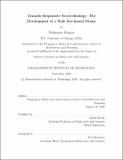| dc.contributor.advisor | Kevin Esvelt. | en_US |
| dc.contributor.author | Kamau, Wakanene(Wakanene Sebastian) | en_US |
| dc.contributor.other | Program in Media Arts and Sciences (Massachusetts Institute of Technology) | en_US |
| dc.date.accessioned | 2021-01-06T20:16:12Z | |
| dc.date.available | 2021-01-06T20:16:12Z | |
| dc.date.copyright | 2020 | en_US |
| dc.date.issued | 2020 | en_US |
| dc.identifier.uri | https://hdl.handle.net/1721.1/129280 | |
| dc.description | Thesis: S.M., Massachusetts Institute of Technology, School of Architecture and Planning, Program in Media Arts and Sciences, September, 2020 | en_US |
| dc.description | Cataloged from student-submitted PDF version of thesis. | en_US |
| dc.description | Includes bibliographical references (pages 45-52). | en_US |
| dc.description.abstract | CRISPR-Cas systems have catalyzed the emergence of several synthetic population management strategies, like gene drives, for controlling pests and disease vectors. As these technologies garner greater visibility in both general and regulatory audiences, questions have arisen about the invasiveness of drive strategies and have underscored a need for community guidance in designing population management technologies. In heterogametic species, an engineered male-determining chromosome can serve as a method for providing robust and localized population suppression without the need for a gene drive. In mice, X-chromosome inactivation is mediated by X-inactive specific transcript (Xist) long non-coding RNA. I propose to encode a system on the Y chromosome to knock out a necessary region for proper X-inactivation in females. Loss of Xist gene function has no known effects in males or females with a dysfunctional maternal copy, however, females who inherit a dysfunctional paternal copy die at embryonic day 8.5. Thus, this results in a male sex-biased mouse. To create a daughterless mouse, my proof-of-principle design will include a constitutively expressed Cas protein with at minimum a two-guide array. Additionally, I will draw on the ecological species concept found in some cultures, like the Māori of New Zealand, to create an alternate eco-cisgenic version using cisgenic murine elements and a CRISPR system found in a commensal species of bacteria. Creating a cisgenic non-driving mammalian model of a genetic population suppression system would be a first-of-its-kind example to show how biological engineering design decisions can be congruent with culturally specific notions of ecology. | en_US |
| dc.description.statementofresponsibility | by Wakanene Kamau. | en_US |
| dc.format.extent | 52 pages | en_US |
| dc.language.iso | eng | en_US |
| dc.publisher | Massachusetts Institute of Technology | en_US |
| dc.rights | MIT theses may be protected by copyright. Please reuse MIT thesis content according to the MIT Libraries Permissions Policy, which is available through the URL provided. | en_US |
| dc.rights.uri | http://dspace.mit.edu/handle/1721.1/7582 | en_US |
| dc.subject | Program in Media Arts and Sciences | en_US |
| dc.title | Towards responsive eco-technology : the development of a male sex-biased mouse | en_US |
| dc.type | Thesis | en_US |
| dc.description.degree | S.M. | en_US |
| dc.contributor.department | Program in Media Arts and Sciences (Massachusetts Institute of Technology) | en_US |
| dc.identifier.oclc | 1227786197 | en_US |
| dc.description.collection | S.M. Massachusetts Institute of Technology, School of Architecture and Planning, Program in Media Arts and Sciences | en_US |
| dspace.imported | 2021-01-06T20:16:12Z | en_US |
| mit.thesis.degree | Master | en_US |
| mit.thesis.department | Media | en_US |
